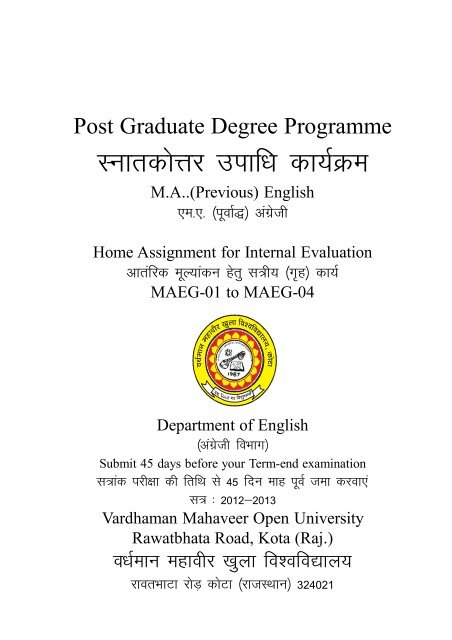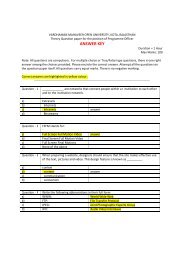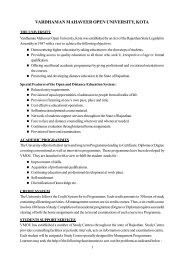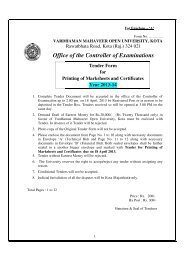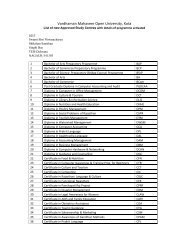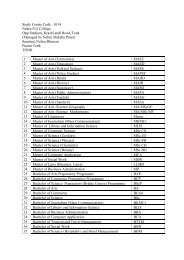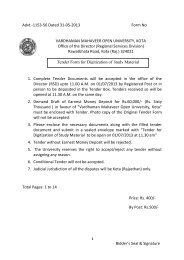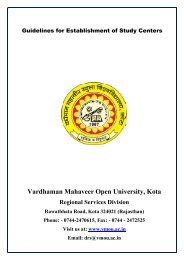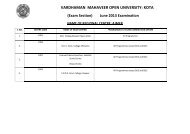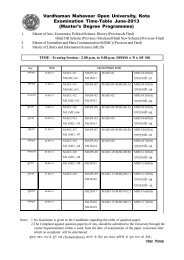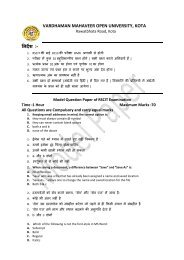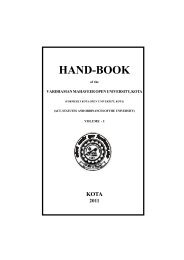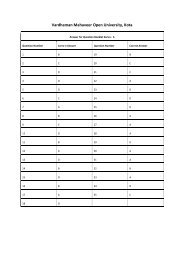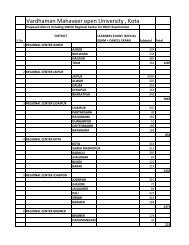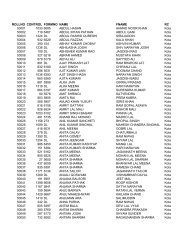LukrdksÙkj mikf/k dk;ZØe - VMOU, Kota
LukrdksÙkj mikf/k dk;ZØe - VMOU, Kota
LukrdksÙkj mikf/k dk;ZØe - VMOU, Kota
You also want an ePaper? Increase the reach of your titles
YUMPU automatically turns print PDFs into web optimized ePapers that Google loves.
Post Graduate Degree Programme<br />
<strong>Lukr<strong>dk</strong>sÙkj</strong> <strong>mikf</strong>/k <strong>dk</strong>;<strong>ZØe</strong><br />
M.A..(Previous) English<br />
,e-,- ¼iwokZ)½ vaxzsth<br />
Home Assignment for Internal Evaluation<br />
vkrafjd ewY;kadu gsrq l=h; ¼x`g½ <strong>dk</strong>;Z<br />
MAEG-01 to MAEG-04<br />
Department of English<br />
¼vaxzsth foHkkx½<br />
Submit 45 days before your Term-end examination<br />
l=kad ijh{kk dh frfFk ls 45 fnu ekg iwoZ tek djok,a<br />
l= % 2012&2013<br />
Vardhaman Mahaveer Open University<br />
Rawatbhata Road, <strong>Kota</strong> (Raj.)<br />
o/kZeku egkohj [kqyk fo”ofo|ky;<br />
jkorHkkVk jksM+ <strong>dk</strong>sVk ¼jktLFkku½ 324021
o/kZeku egkohj [kqyk fo”ofo|ky;<br />
<strong>Lukr<strong>dk</strong>sÙkj</strong> <strong>mikf</strong>/k <strong>dk</strong>;<strong>ZØe</strong><br />
,e-,- ¼iwok)Z½ vaxzsth<br />
vkUrfjd ewY;kadu gsrq l=h; <strong>dk</strong>;Z MA EG-01 to MAEG-04<br />
fiz; Nk=]<br />
vki<strong>dk</strong>s ,e,bth- 01 ls ,e,bZth- 04 rd ikB~;Øe ds fofHkUu iz”u i=ksa ds l=h; <strong>dk</strong>;Z fHktok;s tk jgs gSa] ftu<strong>dk</strong><br />
fooj.k fuEu iz<strong>dk</strong>j gS %&<br />
ikB~;Øe <strong>dk</strong>sM+ iz”u i= <strong>dk</strong> uke<br />
MAEG-01 English Language Usage and Communication Skill<br />
MAEG-02 Renaissance to Jacobean Age<br />
MAEG-03 Caroline to Reformation Age<br />
MAEG-04 The Romantic Age<br />
vkids iz”u^i= esa vki<strong>dk</strong>s l=h; <strong>dk</strong>;Z djus gaSA bUgs iwjk djds vki vfUre frfFk ls iwoZ vius {ks=h; dsUnz ds<br />
funs”kd ds ikl Lo;a mifLFkr gksdj vFkok iathd`r Mkd ls vo”; fHktok nsaA izR;sd l=h; <strong>dk</strong>;Z 20 vad <strong>dk</strong> gSA<br />
nks Js’B iz”uksa ds mÙkjksa ds izkIrkad vkidh l=kad ijh{kk ds lkFk tksMs+ tk;saxsA l=h; <strong>dk</strong>;Z Lo;a dh gLrfyfi esa<br />
djasA rF;kRed =qfV;ksa <strong>dk</strong>s NksM+ dj l=h; <strong>dk</strong>;ksZa <strong>dk</strong> iqueZwY;kad ugha gksrk gS] vkSj u gh bUgs lq/kkjus gsrq nqckjk<br />
Loh<strong>dk</strong>j fd;k tkrk gSaA vr% igyh ckj esa gh loZJs’B mÙkj fy[ksaA izR;sd iz”u&i= ds l=h; <strong>dk</strong>;Z vyx&vyx<br />
QkbZy esa uRFkh djsaA<br />
fo|kFkhZ izFke i`’B ij fuEu lwpuk vfdar djsaA<br />
SSs<br />
M.A.English Programme(Previous)<br />
Scholar number.-----------------------------------<br />
Name of the Student:_____________________ Assignment number:_________________<br />
Father’s name : ------------------------------ Code of Programme: -------------------<br />
Address :------------------------------------<br />
----------------------------------<br />
- -----------------------------------<br />
-<br />
Name of programme :----------------------<br />
Name of study centre:-------------------- Name of regional centre: ----------------<br />
Last date of deposit of Int. Assignment :-----------------------------------------------------------
Post Graduate Degree Programme<br />
<strong>Lukr<strong>dk</strong>sÙkj</strong> <strong>mikf</strong>/k <strong>dk</strong>;<strong>ZØe</strong><br />
M.A..(Final) English<br />
,e-,- ¼mÙkjk)Z½ vaxzsth<br />
Home Assignment for Internal Evaluation<br />
vkrafjd ewY;kadu gsrq l=h; ¼x`g½ <strong>dk</strong>;Z<br />
MAEG-05 to MAEG-11<br />
Department of English<br />
¼vaxzsth foHkkx½<br />
Submit 45 days before your Term-end examination<br />
l=kad ijh{kk dh frfFk ls 45 fnu ekg iwoZ tek djok,a<br />
l= % 2012&2013<br />
Vardhaman Mahaveer Open University<br />
Rawatbhata Road, <strong>Kota</strong> (Raj.)
o/kZeku egkohj [kqyk fo”ofo|ky;<br />
<strong>Lukr<strong>dk</strong>sÙkj</strong> <strong>mikf</strong>/k <strong>dk</strong>;<strong>ZØe</strong><br />
,e-,- ¼mÙkjk)Z½ vaxzsth<br />
vkUrfjd ewY;kadu gsrq l=h; <strong>dk</strong>;Z MAEG-05 to MAEG-11<br />
fiz; Nk=]<br />
vki<strong>dk</strong>s ,e,bZth- 05 ls ,e,bZth- 10 rd ikB~;Øe ds fofHkUu iz”u i=ksa ds l=h; <strong>dk</strong>;Z fHktok;s tk jgs gSa] ftu<strong>dk</strong><br />
fooj.k fuEu iz<strong>dk</strong>j gS %&<br />
ikB~;Øe <strong>dk</strong>sM+ iz”u i= <strong>dk</strong> uke<br />
MAEG-05 Principles of Criticism<br />
MAEG-06 Victorian Age Literature<br />
MAEG-07 Twentieth Century Literature<br />
MAEG-08 Indian Writing in English and in Translation<br />
MAEG-09 Post Colonial Literature<br />
MAEG-10 American Literature<br />
MAEG-11 Canadian Literature<br />
vkids iz”u^i= esa vki<strong>dk</strong>s l=h; <strong>dk</strong>;Z djus gaSA bUgs iwjk djds vki vfUre frfFk ls iwoZ vius {ks=h; dsUnz ds funs”kd ds ikl Lo;a<br />
mifLFkr gksdj vFkok iathd`r Mkd ls vo”; fHktok nsaA izR;sd l=h; <strong>dk</strong>;Z 20 vad <strong>dk</strong> gSA nks Js’B iz”uksa ds mÙkjksa ds izkIrkad<br />
vkidh l=kad ijh{kk ds lkFk tksMs+ tk;saxsA l=h; <strong>dk</strong>;Z Lo;a dh gLrfyfi esa djasA rF;kRed =qfV;ksa <strong>dk</strong>s NksM+ dj l=h; <strong>dk</strong>;ksZa <strong>dk</strong><br />
iqueZwY;kad ugha gksrk gS] vkSj u gh bUgs lq/kkjus gsrq nqckjk Loh<strong>dk</strong>j fd;k tkrk gSaA vr% igyh ckj es a gh loZJs’B mÙkj fy[ksaA izR;sd<br />
iz”u&i= ds l=h; <strong>dk</strong>;Z vyx&vyx QkbZy esa uRFkh djsaA<br />
fo|kFkhZ izFke i`’B ij fuEu lwpuk vfdar djsaA<br />
Lukrk<strong>dk</strong>sÙkj <strong>mikf</strong>/k <strong>dk</strong>;<strong>ZØe</strong> ¼vaxzsth½<br />
¼,e,- mÙkjk)Z½<br />
Scholar number: -------------------------------------------------------------------------------<br />
Name of student:----------------------------Assignment no.------------------------------------<br />
Father’s name--------------------------------Programme code----------------------------------<br />
Address-----------------------------------------------------------------------------------------------<br />
--------------------------------------------------------------------------------------------------------<br />
Name of programme:----------------------------Date of submission:-------------------------<br />
Name of regional centre-------------------------Study centre---------------------------------
MA. (Previous)English<br />
English Language Usage and Communication Skill<br />
Course code: MAEG-1<br />
Internal Assignment- 1<br />
Max. Marks: 20<br />
Answer the following questions. Questions 1&2 have internal choice.<br />
(7Marks each)<br />
Q1. Read the following passage carefully and answer the questions that follow<br />
in your own words:<br />
Since the world has become industrialised, there has been an increase in the<br />
number of animal species that have either become extinct or have neared<br />
extinction. Bengal tiger, for instance, which once romed the jungle in vast<br />
numbers, now number only 2300 and by the year 2025 their population is<br />
esteemed to be down to zero. What is alarming about the case of Bengal tiger<br />
is that this extinction will have been caused almost entirely by poachers who<br />
accordingly to some sourses, are not interested in material gain but in per-<br />
sonal gratification. This is an example of the collousness that is part of what is<br />
causing the problem of extinction. Animal like the Bengal tiger, as well as<br />
those endangered species, are a valuable part of this world’s ecosystem. Inter-<br />
national law protecting these animals must be enacted to ensure their survival,<br />
and the survival of the planet. Countaries around the world have begun to deal<br />
with the problem in various ways. Some countries ,in order to circumvent the<br />
problem, have alocated large amount of land to animal reserves. They then<br />
charge admission to help defray the costs of maintiong th parks, and they<br />
often must also depend on world organizations for support. With the money<br />
get, they can invest in equipment and patrols to protect the animals .Another<br />
solution that is an attempt to stem the tide, of animal extinction is an interna-<br />
tional boycutt of products made from endangered species. This seems fairly<br />
effective, but it will not, by itself, prevent animals from being hunted and<br />
killed.
Q.1 What is auther’s main concern in this passage?<br />
Q.2 Which of the following worlds is closest in meaning to the underlined word<br />
‘Alarming’?<br />
Q.3. What is the meaning of the phrase ‘Stem the tide’?<br />
Q4. Why certain species are becoming extinct ?<br />
Q.5. What solution does the auther suggest for the protection of tigers?<br />
OR<br />
Make notes on the passage given above on the paper.<br />
Q.2. As a staff reporter of Hindustan times, who witnessed a multiple collision of a<br />
Maruti car, a scooter and a tourist bus in a road accident, write a report in not more<br />
than 100 words.<br />
OR<br />
Write notes in 250 words each with suitable examples on the following:<br />
1. Compounding 2. Morphology<br />
Q3. Attempt any two questions . All questions carry equal marks:(3 Marks each)<br />
1. Make one sentence each on the the following sentence patterns and label<br />
them SVOCA:<br />
1. SVO 2. AVOCA 3. SVAA 4. SVOA 5. SVOO<br />
6. SVC<br />
Q.2. Correct the following sentences:<br />
1. The horse and the carriage are at the gate.<br />
2. Not only you but also I are to blame.<br />
3. Ram’s spectacles is very costly.<br />
4. It is you who is to blame for this.<br />
5. Many people lives in slums.<br />
Q.3. Write a note on Electronic Communication.
MA. (Previous)English<br />
English Language Usage and Communication Skill<br />
Course code: MAEG-1<br />
Internal Assignment- 2<br />
Max. Marks: 20<br />
Answer the following questions. Questions 1&2 have internal choice.<br />
(7Marks each)<br />
Q1. Convey the following notions /concepts through a sentence each of your own.<br />
1. Habit 2. Determination 3. Probability<br />
4. Consequence 5. Agreement<br />
Or<br />
Elaborate one of the following themes in the form of a composition.<br />
a) Indian Education system<br />
b) Emergence of technology in life: curse or boon<br />
Q.2. Write notes on the following:<br />
1. Voice Mail 2. Teleconferencing 3. E-Mail<br />
4. Instant Messaging 5. Website<br />
OR<br />
Point out the subordinate and main verb phrases in the sentences below:<br />
a) The boy in that room ia a fresher.<br />
b) Such a sight is very rare.<br />
c) I have got fed up of my hectic social life in Jaipur.<br />
d) Most of the employees in this mall are graduates.<br />
Q.3. Attempt any two questions . All questions carry equal marks:(3 Marks each)<br />
1What is the meaning of summerization? What are the important points for<br />
preparing an effective summary?<br />
2. Define Encoding and Decoding.<br />
3. Describe the main features of effective communication.
MA. (Previous) English<br />
Renaissance to Jacobean Age<br />
Course code: MAEG-02<br />
Internal Assignment-1<br />
Max. Marks: 20<br />
Answer the following questions. Questions 1&2 have internal choice.<br />
Answer the following questions in 500 words each: (7Marks each)<br />
Q1.What are the main features that are represented by Chaucer in his works?<br />
OR<br />
Write a detailed note on the salient features of ‘The Spanish Tragedy’. Differentiate<br />
between Roman revenge tragedy and English revenge tragedy.<br />
Q2. Describe The Duchess of Malfi as a play in the revenge tradition.<br />
OR<br />
Write a note on the themes of lust and greed as developed in The Alchemist.<br />
Q3. Attempt any two questions in not more than 150 words each. All questions<br />
carry equal marks:(3 Marks each)<br />
1. Write a note on the moral and spiritual allegory on the basis of Faerie<br />
Queene?<br />
2. Write a note on Webster’s tragic vision.<br />
3. Explain the following lines<br />
Love is a fervent fire<br />
Kindled by hot desire;<br />
for a short pleasure<br />
Repentance is the hire;<br />
4. Do you think that Chaucer was a social reformer? How?
MA. (Previous) English<br />
Renaissance to Jacobean Age<br />
Course code: MAEG-02<br />
Internal Assignment-2<br />
Max. Marks: 20<br />
Answer the following questions. Questions 1&2 have internal choice.<br />
Answer the following questions in 500 words each: (7Marks each)<br />
Q1. Do you agree that Dr. faustus is a morility play? How?<br />
OR<br />
Discuss Bacon as a true Renaissance Figure on the basis of his essays.<br />
Q2. Write an essay on the salient features of the Shakesperean tragedy.<br />
OR<br />
Discuss John Donne as a love poet.<br />
Q3. Attempt any two questions in not more than 150 words each. All questions<br />
carry equal marks:(3 Marks each)<br />
1. Write a note on soliloquy as a structural device in the play.<br />
2. Critically appreciate the poem The Extasie.<br />
3. Write a note on the element of Melodrama in Shakespeare’s As You Like it.<br />
4. Discuss the main characteristics of poetry in the Elizabethan Age.
MA. (Previous) English<br />
Caroline to Reformation Age<br />
Course code: MAEG-03<br />
Internal Assignment-1<br />
Max. Marks: 20<br />
Answer the following questions. Questions 1&2 have internal choice.<br />
Answer the following questions in 500 words each: (7Marks each)<br />
Q1.The Battle of the Books contains a satirical background of controversy between<br />
Ancient and Modern authors in England. Discuss<br />
OR<br />
Critically appreciate Andrew Marvell’s poem To His Coy Mistress.<br />
Q2. Discuss Lycidas as a Pastoral Elegy.<br />
OR<br />
Write a detailed note on Milton’s grand style and versification.<br />
Q3. Attempt any two questions in not more than 150 words each. All questions<br />
carry equal marks:(3 Marks each)<br />
1. What is the theme of Milton’s Paradise Lost.<br />
2. What message does the poet want to give in the poem To Deffodils?<br />
3. What aspects of 18th Century are satirized by Pope in The Rape of the<br />
Lock.<br />
4. Comment on the realism in Tom Jones.
MA. (Previous) English<br />
Caroline to Reformation Age<br />
Course code: MAEG-03<br />
Internal Assignment-2<br />
Max. Marks: 20<br />
Answer the following questions. Questions 1&2 have internal choice.<br />
Answer the following questions in 500 words each: (7Marks each)<br />
Q1.Discuss Absolom and Achitophel as a political satire.<br />
OR<br />
Bring out the neo-classical and romantic qualities of Gray’s poetry.<br />
Q2. Discuss The School for Scandal as an artificial comedy.<br />
OR<br />
Write critical appreciations of the poem The Little Blake Boy.<br />
Q3. Attempt any two questions in not more than 150 words each. All questions<br />
carry equal marks:(3 Marks each)<br />
1. Write a note on comedy of manners.<br />
2. Give the significance of the title ‘Moll Flanders’.<br />
3. Write a note on the major poets of Transitional Age.<br />
4. Write a critical appreciation of Collin’s Ode to Simplicity.
MA. (Previous) English<br />
The Romantic Age<br />
Course code: MAEG-04<br />
Internal Assignment-1<br />
Max. Marks: 20<br />
Answer the following questions. Questions 1&2 have internal choice.<br />
Answer the following questions in 500 words each: (7Marks each)<br />
Q1. ‘Nature was his guide and nurse’ Verify the statement throughWordsworth poses<br />
in his poetry?<br />
OR<br />
Write an essay on the pictorial quality of John Keats’s poetry.<br />
Q2. Supernatural agencies play a major role in Coleridge’s poetry.Discuss<br />
OR<br />
Discuss Shelley’s Imagery with reference to Adonais.<br />
Q3. Attempt any two questions in not more than 150 words each. All questions<br />
carry equal marks:(3 Marks each)<br />
1. Write a critical appreciation of the poem To the Grecian Urn.<br />
2. What are the main features of Wordsworth’s poetry.<br />
3. Write a summary of the poem Kubla Khan.<br />
4. Write a note on ballad poetry.
MA. (Previous) English<br />
The Romantic Age<br />
Course code: MAEG-04<br />
Internal Assignment-2<br />
Max. Marks: 20<br />
Answer the following questions. Questions 1&2 have internal choice.<br />
Answer the following questions in 500 words each: (7Marks each)<br />
Q1.Write a note on Shelley’s treatment of nature in the Ode to the West Wind.<br />
OR<br />
Discuss Lamb as a Romantic essayist.<br />
Q2. Discuss Pride and Prejudice as a comedy of Manners.<br />
OR<br />
Discuss the salient features of Hazlitt as an essayist.<br />
Q3. Attempt any two questions in not more than 150 words each. All questions<br />
carry equal marks:(3 Marks each)<br />
1. Write a note on the use of myth and irony in Mary Shelley’s Frankenstein.<br />
2. What do you mean by Romantic Revival?<br />
3. What is importance of ‘allegory’.<br />
4. Write a critical appreciation of ‘Ode to Skylark’.
MA. (Final) English<br />
Principles of Criticism<br />
Course code: MAEG-05<br />
Internal Assignment-1<br />
Max. Marks: 20<br />
Answer the following questions. Questions 1&2 have internal choice.<br />
Answer the following questions in 500 words each: (7Marks each)<br />
Q1.Write a note on the brode division of the subject matter of Natyashastra.<br />
OR<br />
What is Dr. Johnson’s opinion about the unities of time ,action and place?<br />
Q2. Bring out the central idea of the poem ‘An Essay on Man’.<br />
OR<br />
Consider the view that Culture and Anarchy is an indictment of the Victorian<br />
Age.<br />
Q3. Attempt any two questions in not more than 150 words each. All questions<br />
carry equal marks:(3 Marks each)<br />
1. What is the concept of ‘Catharsis’ or ‘Purgation in’ the Poetics?<br />
2. Elucidate the concept of Vakrokti.<br />
3. Write a short note on the nature of rasa.<br />
4. Write short notes on the following:<br />
a) Hamartia b) Peripeteia
MA. (Final) English<br />
Principles of Criticism<br />
Course code: MAEG-05<br />
Internal Assignment-2<br />
Max. Marks: 20<br />
Answer the following questions. Questions 1&2 have internal choice.<br />
Answer the following questions in 500 words each: (7Marks each)<br />
Q1. Discuss, T.S.Eliot as a critic. Support your answer with illustrationsfrom ‘Tradition<br />
and Individual Talent’.<br />
OR<br />
Describe Showalter’s history of Women’s literature.<br />
Q2. Frye gives priority to mythology over ideology. Discuss.<br />
OR<br />
Bring out the central idea of the poem ‘An Essay on Man’?<br />
Q3. Attempt any two questions in not more than 150 words each. All questions<br />
carry equal marks:(3 Marks each)<br />
1. Write a note on Leavis’s views on an ideal critic.<br />
2. Discuss ‘Imagery Homelands’ as a critical work.<br />
3. Discuss Rushdie as a politically commited artist.<br />
4. Anand’s fiction may be called ‘ a literature of protest’. Discuss
MA. (Final) English<br />
Victorian Age Literature<br />
Course code: MAEG-06<br />
Internal Assignment-1<br />
Max. Marks: 20<br />
Answer the following questions. Questions 1&2 have internal choice.<br />
Answer the following questions in 500 words each: (7Marks each)<br />
Q1. Critically analysis the poem ‘Lotus Eaters’.<br />
OR<br />
Discuss the theme of the poem ‘The Deserted Garden’.<br />
Q2. Browning’s characterization establishes him ‘as a poet of man’. Comment<br />
OR<br />
Discuss. through suitable text that Arnold is a Romanticist or Pessimistic poet.<br />
Q3. Attempt any two questions in not more than 150 words each. All questions<br />
carry equal marks:(3 Marks each)<br />
1. Write a note on the nature of similies in Sohrab and Rustam.<br />
2. T.S.Eliot considers ‘The Windhover’, a nature poem.<br />
3. What are the types and aspects of Novel.<br />
4. Autobiographical note and symbolism in Charls Dickens ‘Great Expectations’.
MA. (Final) English<br />
Victorian Age Literature<br />
Course code: MAEG-06<br />
Internal Assignment-2<br />
Max. Marks: 20<br />
Answer the following questions. Questions 1&2 have internal choice.<br />
Answer the following questions in 500 words each: (7Marks each)<br />
Q1. How far do you agree that Silar Marner was written to make a philosophical<br />
point?<br />
OR<br />
Discuss the theme of passion Versus love in ‘Wuthering Heights’.<br />
Q2. Describe in detail Hardy’s art of characterization.<br />
OR<br />
Discuss Mill as a humanist rather than a feminist.<br />
Q3. Attempt any two questions in not more than 150 words each. All questions<br />
carry equal marks:(3 Marks each)<br />
1. Comment Treasure Island as a fascinating novel?<br />
2. Discuss Carlyle as a literary critic.<br />
3. Write an essay on the state of literary criticism in the age of Walter Pater.<br />
4.Comment on the title of Thackeray’s novel ‘Vanity Fair’.
MA. (Final) English<br />
Twentieth Century Literature<br />
Course code: MAEG-07<br />
Internal Assignment-1<br />
Max. Marks: 20<br />
Answer the following questions. Questions 1&2 have internal choice.<br />
Answer the following questions in 500 words each: (7Marks each)<br />
Q1. Discuss the elements of Modernity in the poetry of T.S.Eliot.<br />
OR<br />
What is symbolism? How does W.B.Yeats employ symbolic devices in ‘Sailing<br />
to Byzantium’ ?Discuss.<br />
Q2. Jimmy the protogonist is a true example of post-war youth, in Osborne’s ‘Look<br />
Back in Anger’.<br />
OR<br />
Comment on the significance of the title of Synge’s : ‘The Play Boy of the Western<br />
world’.<br />
Q3. Attempt any two questions in not more than 150 words each. All questions<br />
carry equal marks:(3 Marks each)<br />
1. Write the theme of Eliot’s ‘The Waste Land’.<br />
2. Critically analyse Samuel Beckett’s play ‘Waiting For Godot’.<br />
3. Dylan Thomas employes ortrayal of childhood and imagery in the poem<br />
Fern Hill.<br />
4. Write a note on the element of romance and humour in Shaw’s ‘Saint Joan’.
MA. (Final) English<br />
Twentieth Century Literature<br />
Course code: MAEG-07<br />
Internal Assignment-2<br />
Max. Marks: 20<br />
Answer the following questions. Questions 1&2 have internal choice.<br />
Answer the following questions in 500 words each: (7Marks each)<br />
Q1. In ‘Mrs. Dalloway’ Virginia wollf’s treatment of love is original and psychological.<br />
Discuss.<br />
OR<br />
Elobarate fight and fall as the central theme of the novel ‘A Portrait of the<br />
Artist as a Young Man’.<br />
Q2. ‘Sons and Lovers’ is the first Freudian novel in English. Discuss.<br />
OR<br />
Write a short note on Feminism in Virginia Wollf’s novels.<br />
Q3. Attempt any two questions in not more than 150 words each. All questions<br />
carry equal marks:(3 Marks each)<br />
1. What are the salient features of 20th century literature.<br />
2. Coment on Orwell’s views towards Imperialism.<br />
3. Discuss the features of Huxley’s’ Brave New World’.<br />
4. Critically examine Stephen’s views about the relationship between truth and<br />
beauty in ‘A Portrait of the Artist as a Young Man’.
MA. (Final) English<br />
Indian Writing in English and in Translation<br />
Course code: MAEG-08<br />
Internal Assignment-1<br />
Max. Marks: 20<br />
Answer the following questions. Questions 1&2 have internal choice.<br />
Answer the following questions in 500 words each: (7Marks each)<br />
Q1. Write an essay on Rabindranath Tagore’s spiritual beliefs as presented in<br />
Gitanjali.<br />
OR<br />
Critically analyse Indianness in Toru Dutt’s poetry.<br />
Q2. The novel ‘Untouchable’ is almost a one man show. Discuss.<br />
OR<br />
Write a critical appreciation of the novel Voices in the City.<br />
Q3. Attempt any two questions in not more than 150 words each. All questions<br />
carry equal marks:(3 Marks each)<br />
1. Critically examine Naidu’s poem ‘Palanquin Bearers’.<br />
2. Write a short note on Mysticism.<br />
3. Comment on the element of irony and satire in ‘The Guide’<br />
4.Write a note on feminine sensibility in Kamla Das’ poetry.
MA. (Final) English<br />
Indian Writing in English and in Translation<br />
Course code: MAEG-08<br />
Internal Assignment-2<br />
Max. Marks: 20<br />
Answer the following questions. Questions 1&2 have internal choice.<br />
Answer the following questions in 500 words each: (7Marks each)<br />
Q1. Critically analyse the man- woman relationship in Shashi Deshpande’s The Dark<br />
Holds No Terror.<br />
OR<br />
Inside the Haveli presents an authentic credible and realistic women in world.<br />
Discuss.<br />
Q2. Discus in detail the theme of Dattani’s Final Solutions.<br />
OR<br />
Discuss Mrichchhakatikam as a poetic drama.<br />
Q3. Attempt any two questions in not more than 150 words each. All questions<br />
carry equal marks:(3 Marks each)<br />
1.Justify the title of the play ‘The Abhijnanshakuntalam’.<br />
2. Write a brief note on caste as character in the novel ‘Samskaras’.<br />
3. Write a note on autobiographical genere in Indo-Anglican writers.<br />
4. Critically analyse Tagore’s Gitanjali.
MA. (Final) English<br />
Post -Colonial Literature<br />
Course code: MAEG-09<br />
Internal Assignment-1<br />
Max. Marks: 20<br />
Answer the following questions. Questions 1&2 have internal choice.<br />
Answer the following questions in 500 words each: (7Marks each)<br />
Q1. Things fall apart depicts conflicts arising out of a clash between tractition and<br />
modernity. Discuss.<br />
OR<br />
Ice- Candy- Man attempts to recreat the bitter truths of partition. Discuss.<br />
Q2. How would you read ‘A Letter from India’ as a postcolonial text? Give reason for<br />
your answer.<br />
OR<br />
Analyse the concept of ‘ hybridity’ in post colonial poetry with reference to<br />
Indian, African or Australian poets.<br />
Q3. Attempt any two questions in not more than 150 words each. All questions<br />
carry equal marks:(3 Marks each)<br />
1. Write a short note on post colonial literature.<br />
2. What is the distinction between standard English and englishes?<br />
3. Kamla Das’ poetry expresses a sense of betrayal and disillusionment .Comment.<br />
4.Write a note on the imagery of ‘A Far Cry from Africa’.
MA. (Final) English<br />
Post -Colonial Literature<br />
Course code: MAEG-09<br />
Internal Assignment-2<br />
Max. Marks: 20<br />
Answer the following questions. Questions 1&2 have internal choice.<br />
Answer the following questions in 500 words each: (7Marks each)<br />
Q1. Consider Judith Wright as a post-colonial poet .<br />
OR<br />
Critically evaluate Atwood’s ‘Journey to the Interior’.<br />
Q2. What according to Chatterjee is the difference between community and notion?<br />
Why does Chatterjee title his essay ‘Whose Imagined Community’?<br />
OR<br />
Discuss the contemporaniety of the play ‘Tale -Danda’.<br />
Q3. Attempt any two questions in not more than 150 words each. All questions<br />
carry equal marks:(3 Marks each)<br />
1. Write a brief note on the significance of the title of the poem, ‘I Thank You<br />
God’.<br />
2.What do you understand by the term ‘Identification with the aggressor’?<br />
3. Write short notes on Multiple Identities and Hyperenated.<br />
4.Explain ,how Shiv Kumar universalizes the condition of rural women in his<br />
‘Perceptions of Women’.
MA. (Final) English<br />
American Literature<br />
Course code: MAEG-10<br />
Internal Assignment-1<br />
Max. Marks: 20<br />
Answer the following questions. Questions 1&2 have internal choice.<br />
Answer the following questions in 500 words each: (7Marks each)<br />
Q1. Write a note on the themes of love and death in the poetry of Emily Dickinson.<br />
OR<br />
Describe in detail the element of Mysticism in Whitman’s Poetry.<br />
Q2. ‘Robert Frost is a philosophical poet’. Justify.<br />
OR<br />
A Farewell to Arms is one of the most famous war novels ever written, Is it fair<br />
to call ‘A Farewell to Arms’ an antiwar Novel?<br />
Q3. Attempt any two questions in not more than 150 words each. All questions<br />
carry equal marks:(3 Marks each)<br />
1 Trace out the picaresque element in Huckleberry Finn.<br />
2. Discuss the problem of incest in African American Fiction.<br />
3. Isolation or alienattion is an important theme of The Scarlet Letter. Discuss<br />
4.Discuss, the fusion of the theme of love and war in ‘A Farewell to Arms’.
MA. (Final) English<br />
American Literature<br />
Course code: MAEG-10<br />
Internal Assignment-2<br />
Max. Marks: 20<br />
Answer the following questions. Questions 1&2 have internal choice.<br />
Answer the following questions in 500 words each: (7Marks each)<br />
Q1. What is Miller’s philosophy as a creative artist? Discuss.<br />
OR<br />
What is the portrait of a true thinker and scholar that Emerson draws?<br />
Q2. Is Death of a Salesman a tragedy with an Unheroic hero? Make your observations.<br />
OR<br />
How far do you agree that Thennessee Williams was a romantic Visionary poet<br />
who plundered into American Drama ? Discuss.<br />
Q3. Attempt any two questions in not more than 150 words each. All questions<br />
carry equal marks:(3 Marks each)<br />
1. Discuss, the salient features of Eugene O’Neill’s and Tennessee Williams’<br />
dramas.<br />
2. Which is the greatest threat to the children in The Bluest Eye: racism or<br />
saxism?<br />
3. Comment on the significance of the title ‘A Small Good Thing’.<br />
4. Discuss the relationship of the various characters in the story ‘Vitamins’.
MA. (Final) English<br />
Canadian Literature<br />
Course code: MAEG-11<br />
Internal Assignment-1<br />
Max. Marks: 20<br />
Answer the following questions. Questions 1&2 have internal choice.<br />
Answer the following questions in 500 words each: (7Marks each)<br />
Q1. The intence humanity of the young Canadian poets permeates the poetry created<br />
by them.’Justify.<br />
OR<br />
Discuss Scott as a Social Philosopher.<br />
Q2. The Robert Bridge has some elements of feminism in her poetry. Discuss<br />
OR<br />
Describe in detail the four basic periods in Canadian poetry.<br />
Q3. Attempt any two questions in not more than 150 words each. All questions<br />
carry equal marks:(3 Marks each)<br />
1. What are the themes of Prat’s poetry?<br />
2. Give a brief note on Purdy’s preoccupation with ‘time and space’<br />
3. Write a short note on detachement in Canadian writing.<br />
4. What do you mean by pastoral myth?
MA. (Final) English<br />
Canadian Literature<br />
Course code: MAEG-11<br />
Internal Assignment-2<br />
Max. Marks: 20<br />
Answer the following questions. Questions 1&2 have internal choice.<br />
Answer the following questions in 500 words each: (7Marks each)<br />
Q1. Discuss Margaret Atwood as a feminist writer.<br />
OR<br />
Compare and contrast women’s place in Canadian society as depicted in the<br />
novel with that of in Indian society.<br />
Q2. Write a note on the contribution of Alice Munro to Canadian literature.<br />
OR<br />
Discuss the mental and emotional conflict of Stacy Mac Aindra in detail.<br />
Q3. Attempt any two questions in not more than 150 words each. All questions<br />
carry equal marks:(3 Marks each)<br />
1. Critically analyse Atwood’s novel Surfacing.<br />
2. Attempt an essay on Symbolism in ‘Sans must Die’.<br />
3. ‘Doc’ takes the form of a memory play. Discuss.<br />
4.Discuss the narrative device of Rohintan Mistry.


